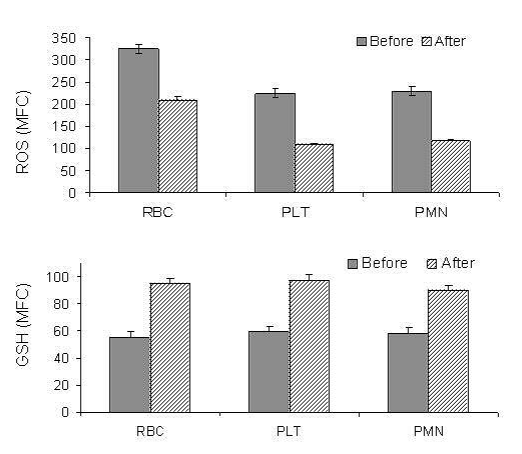Research
Fermented Papaya Preparation as RedoxRegulator in Blood Cells of β-Thalassemic Mice and Patients
FILE2008
Category Bloodβ- ThalassaemiaBasic research
Johnny Amer(1), Ada Goldfarb(1), Eliezer A. Rachmilewitz(2) and Eitan Fibach(1)
Many aspects of the pathology in β-hemoglobinopathies (β-thalassemia and sickle cell anemia) are mediated by oxidative stress.
We tested fermented papaya preparation (FPP) for its antioxidant effects: The scavenging effect, determined spectrofluorometrically in a cellfree system using 2'-7'-dichlorofluorescin-diacetate (DCF).
Both spontaneous and H2O2induced DCF oxidations were decreased by FPP in a dose-dependent fashion.
Using flowcytometry, we showed that in vitro treatment of blood cells from β-thalassemic patients with FPP increased the glutathione content of red blood cells (RBC), platelets and polymorphonuclear (PMN) leukocytes, and reduced their reactive oxygen species, membrane lipid peroxidation and externalization of phosphatidylserine. These effects result in (a) reduced thalassemic RBC sensitivity to hemolysis and phagocytosis by macrophages; (b) improved PMN ability to generate oxidative burst - an intra-cellular mechanism of bacteriolysis, and (c) reduced platelet tendency to undergo activation, as reflected by fewer platelets carrying external phosphatidylserine.
Oral administration of FPP to β-thalassemic mice (50 mg/mouse/day for 3 months) and to patients (3g x 3 times/day for 3 months), reduced all the above mentioned parameters of oxidative stress (p<0.001 in mice and p<0.005 in patients).
These results suggest that FPP, as a potent antioxidant, might alleviate symptoms associated with oxidative stress in severe forms of thalassemia.
 The effect of FPP in thalassemic patients.
The effect of FPP in thalassemic patients.
Nine patients with β-thalassemia were treated with PFF per os (3 g X 3 times a day) for a 3month period. Blood samples were drawn and their RBC, platelets (PLT) and polymorphonuclears (PMN) were analyzed for ROS and GSH. The results depict the average mean fluorescence channels (MFC) ± SD for all treated patients before and 3 months after beginning of the treatment, and indicate a significant (p< 0.005) decrease in ROS and an increase in GSH.
(1)Departments of Hematology, Hadassah - Hebrew University Medical Center, Jerusalem,
(2)The E. Wolfson Medical Center, Holon, Israel
PHYTOTHERAPY RESEARCH Phytother. Res. 22, 820・28 (2008)
List of the related papers
Year
Name of Papers
2012
2011
2010
2010
2010
2008
2006
